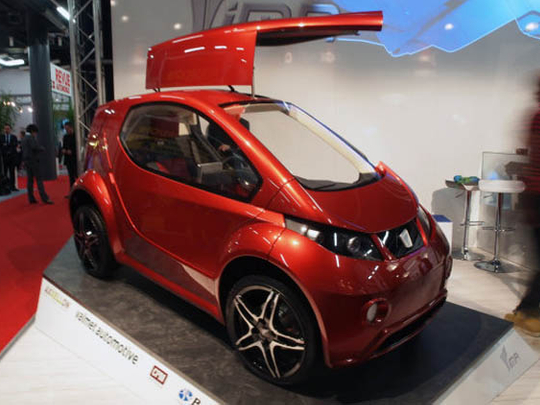
A new car recently made an inconspicuous debut, not in Detroit but in Jena, Germany. With zero CO2 emissions and low energy consumption, the Colibri will be the greenest car on the market when it goes into commercial production this year, its makers say.
“But we don’t market the Colibri as a green vehicle,” adds Thomas delos Santos, CEO of Innovative Mobility Automobile, the company behind the car. “Who wants to buy a vehicle just because it’s green? Cost efficiency is what people care about.”
The Colibri is inexpensive. But perhaps more importantly, its design turns city driving on its head. What started out as “basically a three-wheel bike”, as delos Santos describes it, now has a motor and a chassis. But though it seats a tall man and has space for shopping bags in the boot, the Colibri still measures just 2.75 x 1.30 metres. The seat functions much the same way as race-car seat: it raises itself when the driver gets in and out of the car, then lowers itself when she or he starts driving.
“It doesn’t fulfil everyone’s needs, but it provides safety and comfort,” delos Santos explains. “It’s perfect for well-defined one-person city trips like delivery services, utility companies, and home-care services.”
He has a point: many cars clogging city streets belong not to families, who might need the additional space for other trips, but to businesses dispatching one employee plus equipment. Innovative Mobility Automobile is marketing the Colibri named after the world’s smallest bird to such firms as well as to car-sharing companies.
Early next year, the Colibri will be joined by the Hiriko, another zero-emissions one-seater. And the equally tiny (2.5 x 1.5 metre) car, developed by researchers at the City Science Intiative at MIT (Massachusetts Institute of Technology) and manufactured by a Basque consortium, has an even more unorthodox feature: it can be folded, buggy-style, when parked.
“People in the auto industry say, ‘Why would you want to fold a car? It’s more expensive,’” reports Dr Ryan Chin, one of the MIT team’s leaders. “But it allows you to use less space for parking, and parking plays a huge role in cities today. Cars like the Hiriko can help cities reclaim parking space and use it for things like bikes, parks and sidewalk cafes.”
Three folded Hirikos fit into one parking space, but Chin’s team isn’t stopping at small: it’s envisioning a system where the Hirikos are parked at charging stations around the city and available to anyone in much the same way as city-run bike schemes.
“The market for shared vehicles is very small right now, less than 1 per cent of the total market, so auto-makers don’t see a financial reason to develop shared cars,” notes Chin. “But as the world grows denser, we have to have a new model for shared vehicles.”
According to Andrew Farah, chief engineer for Chevrolet Volt, GM’s popular electric car, the market is seeing the rebirth of the electric car: “We had them in the past, but they died out because gasoline was so cheap. Now they’re being brought back, but the question is, how do you gain customer acceptance?”
The Volt with its backup petrol option, he says, is a “perfect bridging strategy. We’re building a market.” GM plans to expand its range of electric vehicles and is working with utility companies to build a recharging system. VW, meanwhile, recently unveiled Nils, a zero-emission one-seater similar to the Hiriko.
The paradox, of course, is that the new, tiny, environmentally virtuous vehicles can easily lead to city streets being even more clogged. Cities will not just need new charging stations but also new policies.











